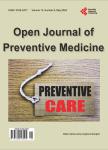Mediation effects of social support on relationships of perceived environment and self-efficacy with school-based physical activity: A structural equation model tailored for Japanese adolescent girls
Mediation effects of social support on relationships of perceived environment and self-efficacy with school-based physical activity: A structural equation model tailored for Japanese adolescent girls作者机构:Faculty of Sport Sciences Waseda University Tokorozawa Japan Graduate School of Education Okayama University Okayama Japan Graduate School of Sport Sciences Waseda University Tokorozawa Japan Sonan Junior High School Okayama Japan
出 版 物:《Open Journal of Preventive Medicine》 (预防医学期刊(英文))
年 卷 期:2013年第3卷第1期
页 面:42-50页
学科分类:1002[医学-临床医学] 100201[医学-内科学(含:心血管病、血液病、呼吸系病、消化系病、内分泌与代谢病、肾病、风湿病、传染病)] 10[医学]
主 题:Public Health Physical Activity Adolescents Correlates Ecological Model Mediator
摘 要:Background: Identifying correlates of physical activity that can be targeted as potential mediators is important for developing interventions to promote physical activity in adolescent girls. However, the mediated effects of multilevel correlates of physical activity remain poorly understood. Therefore, the present study aimed to examine direct and mediated effects of personal, social and perceived school physical environmental factors on school-based physical activity of Japanese adolescent girls. Methods: In this cross-sectional survey of the Japanese adolescent lifestyles, 344 junior high school girls were invited to complete self-report measures of age, grade, weight, height, self-efficacy, social support (family, friends and teachers), perceived school physical environment (equipment, facilities and safety) and physical activity at school (min per week during lunch time and after- school hours). Structural equation modeling analysis controlling for age was performed to examine the effects of body mass index (BMI), self-efficacy, social support and school physical environmental variables on lunchtime and after-hours physical activity. Results: The final structural model demonstrated an acceptable fit for each context-specific physical activity. During lunch recess, perceived equipment and friend support exhibited direct effects on physical activity;perceived facilities, safety, and self-efficacy were indirectly associated with physical activity through friend support. During after-school hours, both family and friend support directly affected physical activity at school;perceived safety, facilities and self-efficacy exhibited indirect effects on physical activity through family or friend support. However, there were no significant associations between equipment and after-school-hours physical activity. Regardless of contexts, BMI had neither direct nor indirect effects on physical activity. Conclusion: Social support from family and friends was identified as fac



